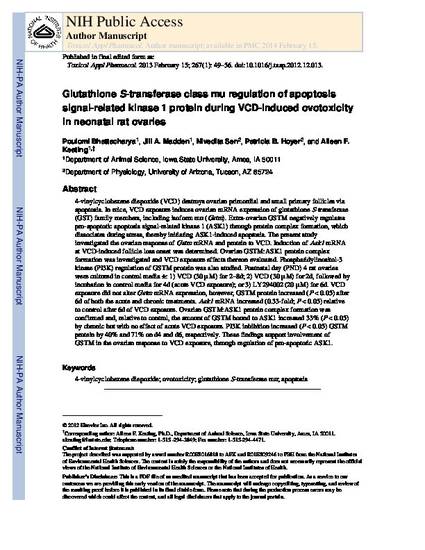
4-vinylcyclohexene diepoxide (VCD) destroys ovarian primordial and small primary follicles via apoptosis. In mice, VCD exposure induces ovarian mRNA expression of glutathione S-transferase (GST) family members, including isoform mu (Gstm). Extra-ovarian GSTM negatively regulates pro-apoptotic apoptosis signal-related kinase 1 (ASK1) through protein complex formation, which dissociates during stress, thereby initiating ASK1-induced apoptosis. The present study investigated the ovarian response of Gstm mRNA and protein to VCD. Induction of Ask1 mRNA at VCD-induced follicle loss onset was determined. Ovarian GSTM:ASK1 protein complex formation was investigated and VCD exposure effects thereon evaluated. Phosphatidylinositol-3 kinase (PI3K) regulation of GSTM protein was also studied. Postnatal day (PND) 4 rat ovaries were cultured in control media ±: 1) VCD (30 μM) for 2–8d; 2) VCD (30 μM) for 2d, followed by incubation in control media for 4d (acute VCD exposure); or 3) LY294002 (20 μM) for 6d. VCD exposure did not alter Gstm mRNA expression, however, GSTM protein increased (P < 0.05) after 6d of both the acute and chronic treatments. Ask1 mRNA increased (0.33-fold; P < 0.05) relative to control after 6d of VCD exposure. Ovarian GSTM:ASK1 protein complex formation was confirmed and, relative to control, the amount of GSTM bound to ASK1 increased 33% (P < 0.05) by chronic but with no effect of acute VCD exposure. PI3K inhibition increased (P < 0.05) GSTM protein by 40% and 71% on d4 and d6, respectively. These findings support involvement of GSTM in the ovarian response to VCD exposure, through regulation of pro-apoptotic ASK1.
Available at: http://works.bepress.com/aileen-keating/17/

This is a manuscript of an article published as Bhattacharya, Poulomi, Jill A. Madden, Nivedita Sen, Patricia B. Hoyer, and Aileen F. Keating. "Glutathione S-transferase class mu regulation of apoptosis signal-regulating kinase 1 protein during VCD-induced ovotoxicity in neonatal rat ovaries." Toxicology and applied pharmacology 267, no. 1 (2013): 49-56. doi: 10.1016/j.taap.2012.12.013. Posted with permission.